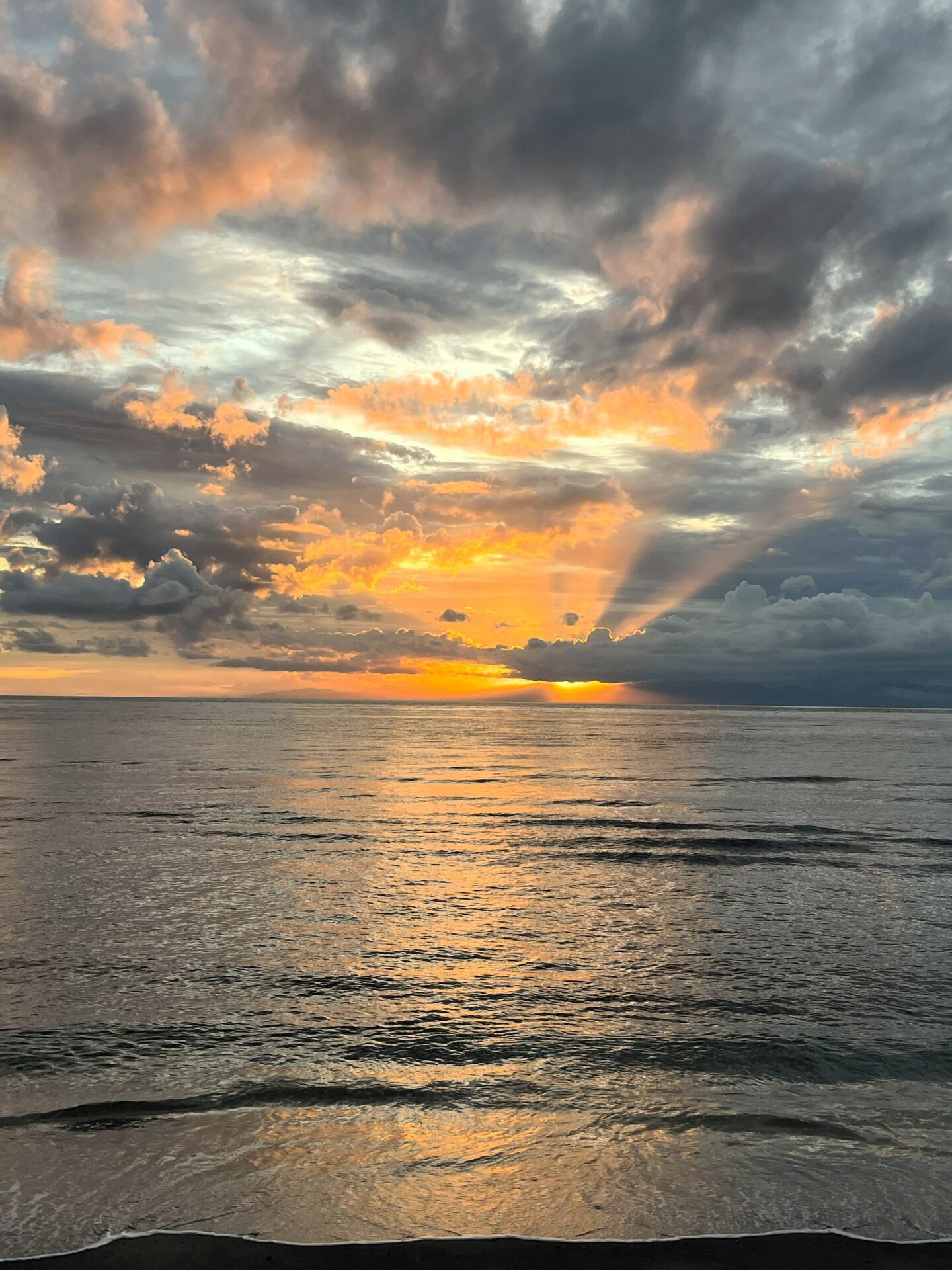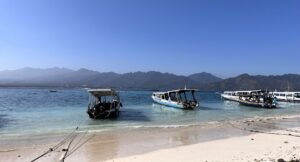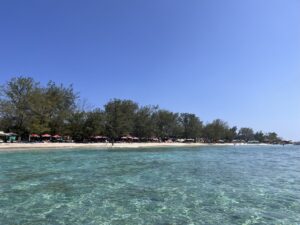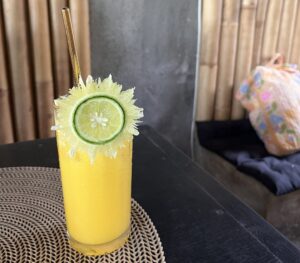If you’re planning to visit Lombok in Indonesia, I recommend starting with the official website of the Indonesian Ministry of Tourism, where you can find useful information such as the country’s currency (IDR), types of sockets, visa requirements, and much more.
Here are some key points to consider when planning your trip to Lombok.
When to visit Lombok
Indonesia has two main seasons: the rainy season, which runs from November to March, and the dry season, which runs from April to October. Although the weather can be unpredictable, these are the general patterns to follow. The best months to visit Lombok are usually April to October.
Some travellers choose to visit in December, as it’s considered low season and prices tend to be lower. There is a higher chance of rain, but that doesn’t mean it will be constant.
You can find out more about Lombok’s weather forecast, including a beach/pool rating for different months of the year here. You can also check that temperatures remain fairly constant throughout the year, with lows around 24°C and highs around 31°C.
From our experience of travelling to Lombok in April and October, and to Bali in July, where the climate is similar, we had more sunny days in October, with some occasional rain in April and July, which always passed quickly. On all three trips, I found the cooler evenings in Bali and Lombok refreshing, especially compared to the constant heat of Singapore.
Tips for planning a trip to Lombok
Another factor to consider is the time of year you’re travelling to Lombok, as Indonesia is a Muslim country and celebrates Ramadan. During this time, people fast during the day and pray at certain times of the day and night, with these prayers being broadcasted over loudspeakers spread across the island of Lombok. Even outside of Ramadan, it’s common to hear the call to prayer at various times of the day, but during Ramadan, the frequency increases, especially at night, which is likely to wake you up. It wasn’t a big problem for me, but for those who have trouble falling back asleep, it’s something to bear in mind when planning your trip and avoid travelling during this time if you think it might disrupt your holiday.
Another important aspect for those traveling to Lombok during Ramadan is that local restaurants are usually closed during the day and only open after sunset when people resume eating.
Entry visas for Indonesia
In the website mentioned previously, there is a section here with updates on visas, including the latest e-VOA (electronic visa on arrival), which can be applied for in advance here. Please note that the e-VOA is not available for all airports/ports of entry in Indonesia. (At the time of updating this post, Lombok Airport is not yet on the list).
I believe there is a small processing fee for the e-VOA, but I’m not sure as I haven’t used it myself.
In the three times we’ve been to Indonesia, we’ve always used the VOA (Visa on Arrival), which is pretty quick. As soon as we get off the plane, we go straight to the VOA queue and simply pay the fee of 500,000 IDR per person, although other currencies such as SGD or USD are also accepted. If you don’t have the exact amount, they will give you change in IDR. You can also pay with a VISA/Mastercard, but I’ve heard that the card payment connections don’t always work, so it’s always good to carry cash just in case.
Check here the list of countries eligible for the VOA (Visa on Arrival), or alternatively use this link and go to ‘List of countries’ and then press ‘details’.
If you are in any doubt about which type of visa you need, you can check the Indonesian Immigration website and fill in the ‘Find the most suitable visa for you’ questionnaire. For Portuguese passport holders like me, for a tourist trip under 30 days, the result will be ‘Visa on arrival – Index B1’.
Whichever type of visa you choose (VOA or e-VOA), you’ll need a valid passport for at least 6 months.
Another good way to find out more about the country you’re traveling to is to visit the website of the Ministry of Foreign Affairs or equivalent in the country of your nationality. In my case, I always check the Portal das Comunidades Portuguesas, which provides useful information for travellers with Portuguese passports by destination. For Indonesia, this is the link.
Portal das Comunidades Portuguesas has information about entry requirements, safety, and health. However, for more detailed health issues, I also usually consult the TravelHealthPro website. This site provides more comprehensive information, including risks associated with diseases such as dengue, malaria, etc., and recommended vaccines for each destination. This site is aimed at travellers from the UK, so not all information may apply to everyone. For information specific to Indonesia, click here.
Can I drink tap water in Indonesia?
Another very important recommendation for travellers to Indonesia is to drink only bottled water, and to consume iced drinks only when we are sure that the ice is made with treated water. The same care should be taken when brushing your teeth, where you should not use tap water. For those travelling with children, it’s always a good idea to remind them of these precautions a few days before the trip, as it will stick in their minds (I suppose).
Hotels usually offer treated water for drinking or brushing teeth, which they provide in the rooms every day.
Flying and getting around Lombok
When it comes to flights, I usually use SkyScanner to see what options are available for a particular destination, and then I make my purchase directly on the website of the airline of my choice, taking into account price and the most convenient schedules.
Since I live in Singapore, Scoot has direct flights to Lombok four days a week. Although the schedules are a bit limited, it’s the most convenient way to get to Lombok.
Another option is to take a domestic flight from Bali to Lombok, as several low-cost airlines offer this quick one-hour route with a few scheduled flights per day.
Alternatively, and probably the most popular option for visitors heading to the Gili Islands (Lombok), is the ferry from Bali. As I mentioned in my post Hotel in Lombok, the ferry ride can be choppy and, in some cases, even risky. If this is your choice of getting to Lombok, always check the reviews of the ferry companies, and consider taking a seasickness tablet, especially during the rainy season when the sea can be rough. It’s also a good idea to check the weather conditions before you set off, although this is the responsibility of the ferry companies, it’s always wise to double check.
Mobile data on the go
Before traveling, I also usually buy a mobile data package, which is always handy for communicating with the hotel or guides in case of flight delays, for example. I use Airalo, which allows buying mobile data packages through an eSIM. Just download the app, create an account, select the country and data package you want, pay, and install the eSIM. For more details, you can check here. Also check that your phone model supports eSIM, which you can do here.
As with any trip, it’s important to have a good health insurance before traveling. Insurance can be purchased for the country of destination or on an annual basis for a specific list of countries.
When it comes to flights, I usually use SkyScanner to see what options are available for a particular destination, and then I make my purchase directly on the website of the airline of my choice, taking into account price and the most convenient schedules.

See also the Arrival in Lombok post for more details on getting to Lombok from Singapore, and what to do when you arrive at the airport.
And here are all the posts about our stay on this incredible island of Lombok.
*This post contains affiliated links, and if you make a reservation/purchase through them I may earn a small commission at no extra cost you.


